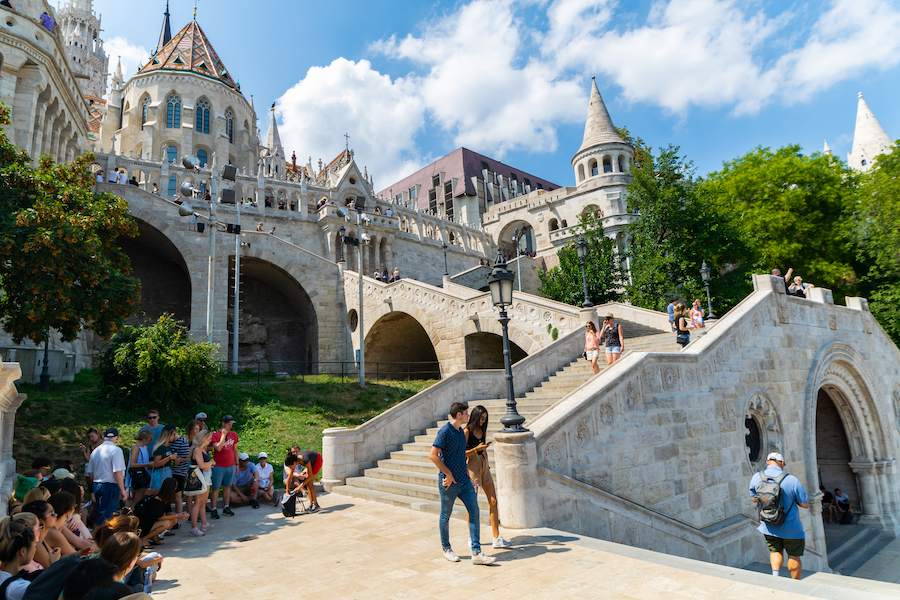Chances are, you’re familiar with a walking tour. The premise for how to create a walking tour is simple —a group of travelers tour an area and listen to stories full of fun facts throughout a guided experience.
And if you’re looking to create a walking tour and haven’t had an aha moment yet, read on for a love letter to walking tours. The benefits are easy to spot since walking tours often are inspired by a passion, inexpensive to start up and are relatively low-risk.
With minimal investment up-front, walking tours can offer a high reward for both guests and tour guides. To get started, you’ll select a location or part of the city you’re based in and begin by exploring possibilities.
As a brilliant experience provider, you can create your own walking tour with just three things — a city, an idea and a theme in mind. In this article, we’ll help you get started.
What is a walking tour?
As a tour guide, you’ll select a destination and share local knowledge with your guests, taking them through a predetermined route.
A good walking tour capitalizes on an interesting area of town. And really, all you need is a map and ideas for your marketing plan.
One crucial point is that walking tours need to become more accessible. Consider offering the option for people to roll, ride or scoot to be more inclusive among kids and people with mobility limitations.
It might help you to look at your city with a refreshing perspective and make some new discoveries along the way.

How to create your own walking tour
1. Evaluate the demand
Before you broadcast the release of your walking tour, you need to know if there’s a market for it. Search online for walking tours in your city to see what types of experiences already exist.
As you go through, ask yourself the following:
- What type of traveller would enjoy this tour?
- How can you set yourself apart?
- What will make your tour different?
You might discover that the area you’re hoping to create a walking tour for is already saturated. Stop by your local visitor centre and see if they may be able to provide market research reports that outline the opportunities and challenges in the industry.
Competitors may also display their brochures and rack cars, which gives you an opportunity to explore the printed brochures. Find out if there are limitations on guests to adhere to social distancing requirements or to reduce the impact on the landscape.
Depending on where you live, you may need to acquire a license to guide walking tours.
2. Identify your target market
The first step in creating a guided walking tour is to research and understand your target market. What’s the demand for walking tours?
One way to do this is to explore a few options you’re considering and observe the type of travelers who frequent the area. Doing so can provide you with demographic insights that you can then apply to design your walking tour.
Imagine living in Seattle or San Francisco, where there are some seriously steep hills. Is it likely that guests are going to be able to walk as quickly?
Make a point to identify the types of travelers that happen to be excited about and looking for the kind of walking tour you’re creating.
3. Decide on the theme
Choosing a theme will depend on where you live. Will you be showcasing the architecture in your city, highlighting local cuisine or offering a seasonal guided experience like a ghost tour?
Differentiate from competitors by evaluating how you can broaden your audience and provide something they are excited about. For instance, how can you offer a walking tour at night and still make people feel safe? Groups and a well-lit route choice will help guests feel more at ease.
Or, is there an area of your city that you know a lot of people travel to independently but miss the real hidden gems? Is it possible for you to offer different variations of the same tour so older travelers or kids can join in?
4. Create a tour itinerary
Understandably, travelers generally like to see a full itinerary online before deciding to book a tour.
When writing a description, lead with the highlights of your tour itinerary to help guests figure out if your walking tour is a good fit.

Choose a walking tour niche
Select attractions to include along the route
As an experience provider, it’s pivotal that you are jazzed by the thought of sharing your tour with others.
And since you’ll be repeating facts and stories multiple times, can you choose attractions that provide you with ample content? The theme of your tour will help you determine the kind of sites to include.
Your walking tour might focus on architecture, historical sites or local cuisine or a mix of all three. In fact, many walking tours also crossover into food tours, making them a delicious adventure for guests who enjoy getting to know the local artisans who prepare their savoury fare.
For an idea of how to create your own walking tour, Tourpreneur offers a detailed explanation of how to start one without having any prior experience.
Choose a duration
A walking tour can be super short or leisurely and long. So while an introductory walking tour might not include extras like food or drinks, they can still provide guests with meaningful insight.
Interestingly, most walking tours tend to be advertisted as approximately two hours. It’s a great idea to include plenty of breaks — otherwise people would just go to the gym to get their exercise!
You’ll be able to gauge how much ground you can cover, and how many locations you’ll realistically be able to include by taking a practice route of your tour.
It’s important to give guests enough time to meander from place to place. Arguably, it’s better to leave guests with more energy left to explore and provide them with a few of your favourite spots to check out on their own.
Create a walking tour map
How cool is it to be able to create a map of your own walking tour? In case you haven’t come across this yet, there’s a tool in Google maps to note your favourites and save points of interest. This allows you to then design a custom map that you can share with guests.
To create a walking tour map , you’ll want to login to (or set up) your Google account and make sure you have all of your favourite attractions saved, first. Then, choose to save the map and email it to your booked guests so they can follow along or get back on track if they become lost.
Determine your costs
Before you start booking tours and charging your guests, you need to figure out what kind of costs you can expect to deal with.
Find out how much it will take to produce your walking tour. Start by researching potential expenses like permits, licensing, restaurants and any swag items you’re thinking of giving tour guests.
Then, account for how much you’d like to be compensated for your time, including doing the administrative work to prepare for your tour.
Doing the math will allow you to see which type of tour will increase your quality of life and profitability. Ensure you’re not undercutting the competition to capture a portion of the market. This can lead to burnout and leave a bad taste amongst the guiding community.

Build Relationships
Market your tours
Aim to grow your business through word of mouth, local partnerships and social media, before investing in paid ads. A well-curated online presence and website will help to generate business over time, as well.
With most guests searching online, it’s not necessary to invest in printing brochures or flyers when starting your walking tour business. In fact, it’s better to try to build community connections with local restaurateurs and other guides to be upfront about what you’re looking to offer.
Invest in partnerships
Some of the strongest tour brands establish social channels to keep people in the loop before their walking tour is available to book. Can you explore partnerships with local artisans, cuisine, cafes or breweries to make your tour more of an exceptional experience?
Seek out feedback
Draw intrigue and get a sense of the demographics interested in your walking tour. Make a point to respond to any queries online and invite questions for a direct feedback loop.
It can be as simple as posting a photo from a slightly different angle or a fun find or breathtaking architecture illuminated against the night sky.
Claim listings on Review Sites like Google and Tripadvisor. Over time, as you gain feedback from customers, this will help generate visitors for your website. Review sites can work as a powerful marketing tool, especially since many customers admit to reading reviews before booking a tour.
Practice makes perfect
Do a test run
Take a small group through your guided tour route. Start by including people you know and ask for their honest opinion. While on tour, be sure to project loud enough to enable all of your guests to hear you.
Following your tour, ask your guests the following open-ended questions:
- What makes this tour engaging and fun?
- What’s your favourite part of the tour?
- What would you like to see while on this tour?
- How far are you willing to walk?
- How many different places would you like to visit while on tour?
Make a point to request feedback from your guests within 1-3 days of their experience. For instance, do customers think you are too casual or that you talk too much?
Feedback provides you with this kind of helpful insight, so you can gain an edge on your competition and consistently add fun elements to your walking tour.
Go above and beyond
Ultimately, your price will create a perceived value for the tour. If you are only charging $-$$ for an hour, guests might not expect much, but if you charge $$$ for a tour that lasts 2+ hours, expectations will naturally increase.
Deliver beyond the expectations and look for ways to leave guests feeling like the walking tour was well worthwhile. Consider whether a memento or photo will leave guests with a memorable experience.
Continue practicing your storytelling chops and keep learning more about the city where you’re offering your tours. So, if you believe your experience is full of value, dig into marketing to put your best offer forward and lead with value.

What makes for a good walking tour
- A genuine, reliable tour guide
- A realistic timeframe
- A route that’s clear and easy to follow
- Storytelling skills
- Opportunities for guests to ask questions
- Quality food experience
- Variety in attractions
As a tour guide, the product you’re selling is the experience you provide. The better you develop a candid, entertaining approach to offering a walking tour, the more easily word will spread so guests will be inspired to find out for themselves.
Final thoughts
Creating a walking tour is one of the most cost-effective ways to kickstart a tour business. The benefits allow you to get outside, meet new people, share local insight and wow customers, all without massive overhead.
Refine your walking tour as you go and continue to innovate to stand out from your competitors.
It may take some time to get warmed up, and you’ll probably encounter some bumps along the way, but it’s all worth it once you see how much joy (or fright!) your guests get out of the experience.
Looking for an online booking system that can help you sell with ease?

Take your business to the next level
Online bookings. Flexible pricing. Outstanding support.



